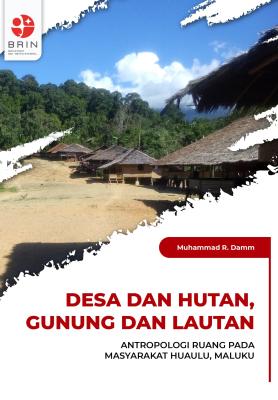Desa dan Hutan, Gunung dan Lautan: Antropologi Ruang pada Masyarakat Huaulu, Maluku
Keywords:
Kajian antropologis, Masyarakat Huaulu, Pola keruangan, Pulau SeramSynopsis
Frasa pada judul buku ini, Desa dan Hutan, Gunung dan Lautan, mengindikasikan empat penanda arah yang dikenal masyarakat Huaulu, yakni "ria" dan "roe," "rai", dan "lau". Keempatnya biasa diterjemahkan ke dalam bahasa Indonesia menjadi barat dan timur, selatan, dan utara. Seluruh pembahasan di dalam buku ini, jika hendak direduksi, merupakan upaya pemugaran atas keempat mata arah tersebut. Apa yang ingin ditunjukkan, alih-alih merujuk pada arah mata angin konvensional, keempat mata arah Huaulu tersebut justru terorientasi pada desa sebagai dunia dalam, hutan sebagai dunia luar, gunung yang berasosiasi dengan langit (atas), serta lautan yang berasosiasi dengan bumi (bawah). Melalui eksplorasi atas empat mata arah ini, pembaca diajak untuk memahami semesta pikir Huaulu memandang jagat mereka (kosmologi).
Buku ini diperuntukkan tidak hanya bagi mahasiswa, pelajar, peneliti, pengajar, dan akademisi di bidang antropologi, tetapi juga dapat menjadi bacaan yang menarik bagi pembaca yang menyukai keanekaragaman budaya masyarakat di Nusantara dengan kearifan lokalnya yang khas.
Downloads
References
Ansori, M. H., Sukandar, R., Peranto, S., Karib, F., Cholid, S., & Rasyid, I. (2014). Segregasi, kekerasan, dan kebijakan rekonstruksi pasca-konflik di Ambon. SNPK–THC.
Aranha, J. L. (1991). A comparison of traditional settlements in Nepal and Bali. TDSR, 2, 35–47.
Descola, P. (2013). Beyond culture and nature. The University of Chicago Press.
Descola, P. (2014). Modes of being and forms of predication. HAU Journal of Ethnographic Theory, 4(1), 271–280.
Durkheim, E. (1995). The elementary forms of religious life. The Free Press.
Durkheim, E. & Mauss, M. (2009). Primitive classification. Routledge Revivals.
Ellen, R. (1986). Microcosm, macrocosm and the Nuaulu house: concerning the reductionist fallacy as applied to metaphorical level. Bijdragen tot de Taal-, Land- en Volkenkunde, 142(1), 1–30.
Fernandez, J. (2003). Emergence and convergence in some African sacred places. Dalam S. M. Low & D. Lawrence-Zúñiga (Ed.), The anthropology of space and place (187–203). Blackwell Publishing.
Fox, J. J. (Ed.) (2006). Inside Austronesian houses: Perspectives on domestic designs for living. ANU E Press.
Geertz, C. (1973a). Thick description: Toward an interpretive theory of culture. Dalam C. Geertz, The interpretation of cultures (3–30). Basic Books, Inc.
Geertz, C. (1973b). Religion as a cultural system. Dalam C. Geertz, The interpretation of cultures (87–125). Basic Books, Inc.
Goonewardena, K., Kipfer, S., Milgrom, R., & Schmid, C. (Ed.). (2008). Space, difference, everyday life: Reading Henri Lefebvre. Routledge.
Grimes, B. D. (1997). Knowing your place: representing relations of precedence and origin on the Buru landscape. Dalam J. J. Fox (Ed.), The poetic power of place: Comparative ideas of locality (115–130). ANU E Press.
Hobart, M. (1979). A Balinese village and its field of social relations [Disertasi tidak diterbitkan]. University of London.
Howe, L. (2005). The changing world of Bali: Religion, society and tourism. Routledge.
Hubert, H. & Mauss, M. (1964). Sacrifice: Definition and its function. University of Chicago Press. (Karya orisinal diterbitkan 1889)
Lefebvre, H. (1991). The production of space. Blackwell. (Karya orisinal diterbitkan 1974)
Levi-Strauss, C. (1963). Do dual organizations exist? Dalam C. Levi-Strauss, Structural Anthropology (132–163). Basic Books, Inc.
Levi-Strauss, C. (2013). The culinary triangle. Dalam C. Counihan & P. Van Esterik (Ed.), Food and culture: A reader (40–47). Routledge. (Karya orisinal diterbitkan 1966)
Low, S. M. (1996). Spatializing culture: The social production and social construction of public space in Costa Rica. American Ethnologist, 23(4), 861–879.
Low, S. M. (2014). Spatializing culture: An engaged anthropological approach to space and place. Dalam J. J. Gieseking, W. Mangold & C. Katz (Ed.), The people, place, and space reader (34–38). Routledge.
Martodirdjo, H. S. (1994). Organisasi sosial orang Tugutil di Halmahera. Dalam L. E. Visser (Ed.), Halmahera and beyond: Social science research in the Moluccas (115–138). KITLV Press.
Munn, N. D. (1996). Excluded spaces: The figure in the Australian Aboriginal landscape. Critical Inquiry, 22(3), 446–465.
Parkin, D. (1992). Ritual as spatial direction and bodily division. Dalam D. de Coppet (Ed.), Understanding Rituals (11–25). Routledge.
Poesponegoro, M. D. & Notosusanto, N. (1993). Sejarah nasional Indonesia IV. Balai Pustaka.
Reuter, T. (Ed.). (2006). Sharing the earth, dividing the land: Land and territory in the Austronesian world. ANU E Press.
Tjahjono, G. (1989). Cosmos, center, and duality in Javanese architectural tradition: The symbolic dimensions of house shapes in Kota Gede and surroundings [Disertasi tidak diterbitkan]. University of California at Berkeley.
Tuan, Y.-F. (2001). Space and place: The perspective of experience. University of Minnesota Press. (Karya orisinal diterbitkan 1977)
Turner, V. (1969). The ritual process: Structure and anti-structure. Cornell University Press.
Valeri, V. (1994). ‘Our ancestors spoke little’: knowledge and social forms in Huaulu. Dalam L. E. Visser (Ed.), Halmahera and beyond: social science research in the Moluccas (195–212). KITLV Press.
Valeri, V. (2000). The forest of taboos: morality, hunting, and identity among the Huaulu of the Moluccas. The University of Wisconsin Press.
Valeri, V. (2001a). Notes on the meaning of marriage prestations among the Huaulu of Seram. Dalam V. Valeri, Fragments from forests and libraries (137–152). Carolina Academic Press. (Karya orisinal diterbitkan 1975–1976)
Valeri, V. (2001b). Parts and wholes: social and conceptual dualism in the Central Moluccas. Dalam V. Valeri, Fragments from forests and libraries (93–136). Carolina Academic Press. (Karya orisinal diterbitkan 1983)
Valeri, V. (2001c). Temporal forms of society: chronological and subjective time, mythical and historical time among the Huaulu (Eastern Indonesia). Dalam V. Valeri, Fragments from forests and libraries (311–332). Carolina Academic Press. (Karya orisinal diterbitkan 1996)
Wattimena, L. (2015). Rumah orang Huaulu, Pulau Seram Maluku Tengah. KAPATA Arkeologi, 11(2), 155–164.

Downloads
Published
Series
License

This work is licensed under a Creative Commons Attribution-NonCommercial-ShareAlike 4.0 International License.






























